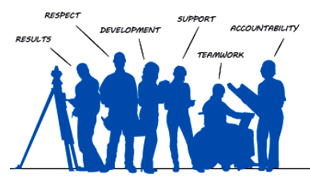

ITD using constructive-based interviewing process to better align potential employees with values and culture of organization
More efficient and effective interviewing is the aim behind a new technique the Division of Human Resources team implemented this year. ITD has made a number of hiring decisions in the last few months using this new technique – rather than the traditional Q&A interviewing process to assess candidates. This new technique puts all of the candidates together to solve a problem and then the hiring team observes the behavior that transpires. Usually someone steps forward to take the leadership role. Some others hang back, and some filter to the outer edges of the room, unwilling to engage.
But the people who assume the leadership roles may not necessarily be the best fit, if they are inflexible and not open to the thoughts/direction of the group. Likewise, the people who hang back are not necessarily a bad fit – they may just be evaluating and taking the temperature of the others in the room in order to make a more informed decision.
"Traditional behavioral-based interviewing attempts to predict a candidate's future work behavior based on how they answer questions about past behavior," explained Chief Human Resource Officer Brenda Williams. "At ITD, the DHR team has taken that one step further."
"We are using group interviews to observe behavior as a way of predicting future behavior. We learn not only how a candidate thinks, but how he or she interacts with others — do they listen or talk over others? Do they make the people around them better or do they bully others? Do they complain about problems or generate solutions?"
Using group interviews helps narrow the field of potential candidates, according to Williams. "We can then spend more time with the candidates who are the best fit."
So instead of 12, one-hour interviews to determine the top four candidates, a one-hour group process will identify the best potential employees to move on to a second-round interview.
"To ensure we are hiring the best, we had to change our hiring approach," Williams said. "I am proud of the innovative approach the DHR team has taken to improve the interviewing process. Since implementing this new approach, it has spread quickly throughout the organization, with a number of creative variations."
In Port-of-Entry interviews, for example, candidates view two short training videos and apply what they've learned to a realistic case study. In some maintenance sheds, the employees interview the candidates over lunch or on a tour and make a recommendation to the foreman. In other group interviews, candidates work as a team to prioritize tasks or problem-solve a list of issues they may face on the job. 
"Through this process, we learn more about candidates and get multiple perspectives by involving a variety of people. This helps us make better hiring decisions that align with our values and culture at ITD."
Just a few years ago, only employees at the same level or higher than the position being hired could participate in the hiring and selection. Today, we are involving more employees in the process. Recently, Jason Minzghor, District Engineer in D6, had all the maintenance supervisors play an integral role in interviewing their future boss," Williams said. "Minzghor told us the process helped quickly identify the top candidates, while engaging and empowering the team in the hiring process."
"This innovative approach to hiring is quite a change from the way we used to do things, but it is a change that will help make ITD the best transportation department in the country."
Published 09-02-16